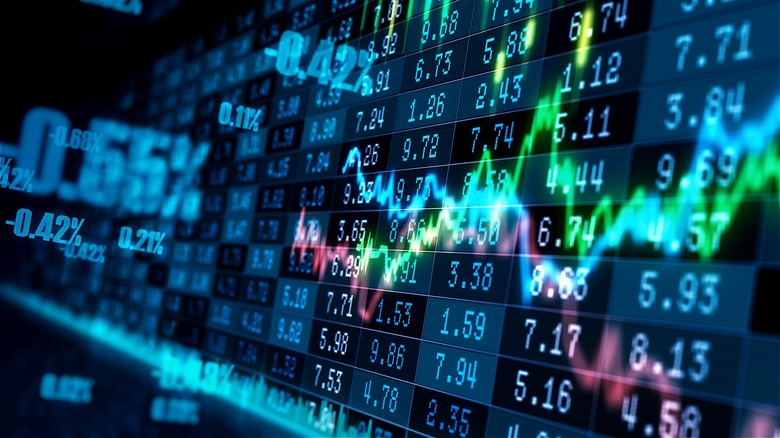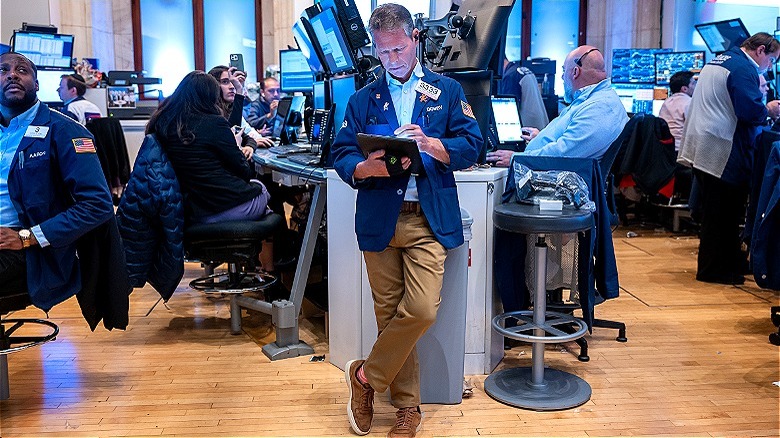What Is A Stock Market Bubble?
While you've probably heard of the concept of a market bubble bursting (for example, the dot-com bubble in 2000), it might have left you wondering just what, exactly, a stock market bubble was in the first place. We've all experienced the unfortunate fallout of one of these asset bubbles bursting or crashing, with a more contemporary example being the housing market crash of 2008 (although this was a credit bubble, but we'll get to that). It can be especially important to understand the elements of a stock market bubble given current economic circumstances and recent stock market interest (and gains) in the so-called Magnificent Seven tech-focused stocks.
Despite analysis claiming Wall Street isn't yet in "bubble territory," there are early indications we could be heading toward a burst when it comes to the growth of these Magnificent Seven stocks and investments in their AI programs. This is especially true when you compare current economic factors to previous bubbles like, say, the dot-com bubble. UBS Chief Strategist Bhanu Baweja told investors in March 2024 (via CNBC), "The 90s bull run saw two phases: a broad, steady climb from early '95 to mid '98, and then a narrower, more explosive phase from late '98 to early '00. Today's sectoral patterns, narrowness, correlations, are similar to the second phase of the market; valuations are not far off either."
For anyone who's unsure, the term bull market is when prices, and investor confidence in the continuation of those prices, are high. This overconfidence can lead to a subsequent overvaluation of a stock, and by a large margin.
Identifying a bubble
A stock market bubble is when shares of a stock rapidly rise in price, usually far above what the fundamental value of that stock (or company) is actually worth. The speculative demand behind the stock's price fuels further inflated prices that, at some point, will reach their limit. Once that limit is reached, massive sell-offs and subsequent price declines lead to a crash. What makes a stock market bubble different from other bubbles (such as asset market, credit, or commodity) is that this bubble only involves equities or shareholders' value. While a stock market bubble can involve the entire stock market, it can also more specifically affect equities in certain industries or markets (like, for instance, tech companies).
Stock market bubbles generally have five stages. These stages can help analysts, as well as regular people, understand the early warning signs of a bubble, and hopefully be able to prevent a burst (or prepare for a stock market crash). The first stage is displacement, which is another way of saying when investors suddenly fixate on the newest thing. Stage two is boom, in which more participants and investors enter the market to support the same stocks as initial investors — leading to growing momentum. This stage also usually includes extensive media coverage. In today's context, a good example of these stages would be Wall Street's recent artificial intelligence boom, which has received quite a bit of media attention. Stage three is euphoria, in which valuations reach disproportionately high levels with the expectation that there will always be a market to pay more.
A bubble burst
The last two stages of a stock market bubble are ultimately centered on the bubble bursting. Stage four is profit-taking; in this stage, investors who are aware of the warning signs of a bubble bursting will begin selling off their shares (at the previously mentioned disproportionately high prices) in order to make as much profit as possible from the situation. With that in mind, many investors and speculators who see the burst coming will try to wait as long as possible to sell in order to make as much money as possible before the collapse. However, this can be difficult to properly time since the market is inherently unpredictable. The fifth and final stage is panic, which ultimately leads to the bubble bursting. Since the market (and crashes in particular) is inherently unpredictable, any number of things big or small can end up being the catalyst that spooks investors and speculators to rapidly liquidate their shares. Prices will then plummet, as supply overtakes demand, causing not only investor values to drop but also asset prices.
This brings us back to current-day tech and AI-heavy investments. With larger bubble bursts, the country could experience stock market crashes, or even an economic recession or a depression. As Jeremy Grantham, an investor who predicted both the dot-com crash in 2000 and the 2008 crisis, explained it to CNN, it "seems likely that the after-effects of interest rate rises and the ridiculous speculation of 2020 to 2021 and now (November 2023 through today) will eventually end in a recession."


